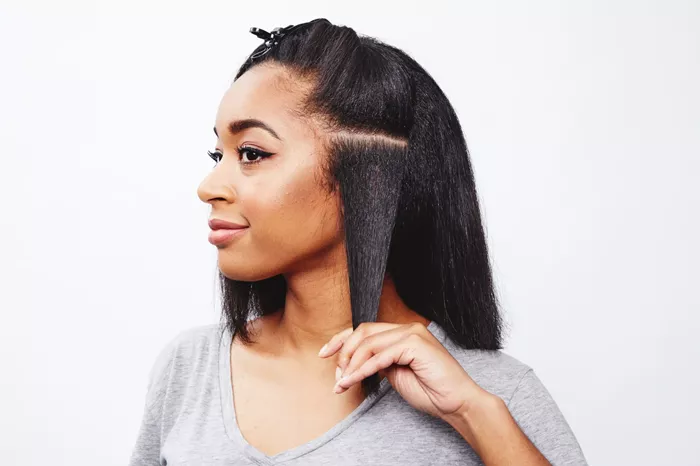Black curly hair, particularly Type 4 textures (4a, 4b, 4c), is characterized by tight coils, high density, and delicate cuticles. This hair type is more prone to dryness and breakage due to its natural oils struggling to travel down the spiral-shaped strands. When straightening, the goal is to temporarily relax these coils without compromising the hair’s integrity. Heat styling must be approached with caution—excessive temperatures or improper techniques can lead to irreversible damage, such as protein loss, split ends, or heat-induced alopecia. The key lies in balancing moisture retention, heat protection, and precision styling.
Before reaching for any tools, assess your hair’s health. If your hair is already damaged (e.g., brittle ends, excessive shedding), prioritize deep conditioning treatments for 4–6 weeks before attempting heat styling. Invest in a high-quality flat iron with adjustable temperature settings (ceramic or titanium plates are ideal) and a fine-tooth comb for sectioning. Avoid using blow dryers without a comb attachment, as they can cause uneven tension and frizz.
Pre-Styling Preparation: The Foundation for Success
Straightening black curly hair starts long before heat is applied. Begin with a clarifying shampoo to remove product buildup, which can block heat penetration and cause uneven results. Follow with a moisturizing conditioner rich in ingredients like shea butter, argan oil, or hydrolyzed keratin. These components temporarily smooth the hair cuticle and add elasticity, reducing the risk of snapage during styling. For extra protection, apply a protein treatment once a month—look for products with amino acids or silk proteins to reinforce weak bonds.
After rinsing, gently detangle hair with a wide-tooth comb while it’s still damp. Avoid rough towel-drying; instead, blot hair with a microfiber towel or cotton T-shirt to minimize friction. Apply a heat protectant spray or serum evenly from roots to ends. Focus on mid-lengths and ends, where heat exposure is longest. Let hair air-dry until it’s 90% dry, then use a blow dryer with a comb attachment on medium heat to fully dry and stretch the hair. This pre-straightening step reduces the amount of direct heat needed later.
The Step-by-Step Straightening Process
Divide your hair into 6–8 manageable sections using butterfly clips. Start at the nape of the neck—this area typically dries fastest and benefits from early heat application. Take a subsection no wider than 1 inch (thicker sections won’t heat evenly). Clamp the flat iron as close to the roots as possible without touching the scalp. Slowly glide the iron down the hair shaft in one smooth motion. Avoid going over the same section repeatedly; 1–2 passes max. For stubborn coils, slightly increase the iron’s temperature (max 380°F for coarse hair) but never exceed 400°F.
As you work upward, adjust your technique for the crown and edges. These areas are often finer and more fragile. Reduce the iron’s temperature by 20–30°F and use lighter pressure. For baby hairs or short edges, wrap them around the flat iron in a rolling motion instead of clamping. Once all sections are straightened, run a boar bristle brush through your hair to distribute natural oils and enhance shine. Avoid heavy oils or creams post-styling—they can revert straightened hair in humid conditions.
Post-Styling Care to Maintain Smoothness
Straightened black hair is highly susceptible to moisture, which can cause reversion (poofing). To prolong your style, sleep on a silk or satin pillowcase and wrap hair in a silk scarf overnight. In the morning, refresh roots with a light mist of dry shampoo and smooth flyaways with a dab of anti-frizz serum. Avoid sweating, rain, or steam—if exposed, immediately blot hair dry and use a flat iron on low heat (300°F) to reseal the cuticle.
For workouts, tie hair into a loose ponytail or braid to minimize friction. If your roots begin to puff, apply a small amount of edge control gel and press with a warm (not hot) flat iron. Rehydrate ends daily with a water-free moisturizer containing dimethicone or cyclopentasiloxane—these silicones create a moisture barrier without adding water weight.
Common Mistakes That Lead to Damage
Skipping Heat Protectant: Direct heat on unprotected hair melts the cuticle, causing permanent porosity.
Using Dirty Tools: Product residue on flat irons transfers to hair, creating buildup and uneven heat distribution. Clean plates weekly with rubbing alcohol.
Overlapping Passes: Repeatedly ironing the same spot thins the hair shaft, leading to breakage.
Ignoring Humidity: High moisture environments demand stronger anti-reversion products. Use a humidity-blocking spray before stepping outside.
Tugging Tangles: Forcing a flat iron through knots snaps strands. Always detangle thoroughly before heating.
If you notice excessive shedding or white bulb hairs after straightening, discontinue heat immediately and focus on protein-moisture balance treatments.
Alternatives to Heat for Temporary Straightening
Heat-free methods offer safer options for those avoiding thermal damage:
Tension Blowouts: Use a blow dryer and round brush to stretch hair without direct iron contact.
Roller Sets: Wrap damp hair around magnetic rollers and sit under a hooded dryer. Results last 1–2 weeks.
Chemical-Free Stretching: Braid hair into large cornrows while damp. Air-dry or diffuse for a stretched base.
When to Consider Professional Help
If home straightening consistently yields frizz, uneven results, or damage, consult a licensed stylist specializing in textured hair. They may recommend:
Keratin Treatments: Semi-permanent straightening that lasts 3–5 months. Avoid formaldehyde-based formulas.
Press-and-Curl Services: Combines heat styling with expert tension control for salon-grade smoothness.
Trim and Recovery Plans: Cutting damaged ends and restoring health before further styling.
Conclusion
Straightening black curly hair can be safe if approached with patience and knowledge. Prioritize moisture, moderate heat, and regular trims. Remember, sleek hair means nothing if it’s breaking off at the roots. Embrace protective styles between heat sessions, and never let aesthetics compromise the resilience of your curls. With these strategies, you’ll achieve glossy, straight hair that snaps back to its natural glory when desired.
Related topics:
9 Best Short Black Hairstyles for 2025
12 Ways to Style Short Black Hair, According to Hairstylists
How to Style Short Permed Black Hair


